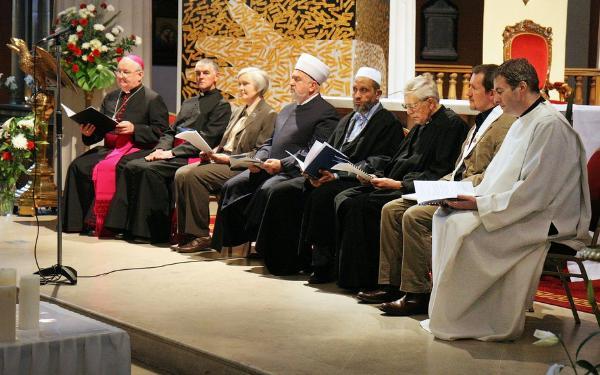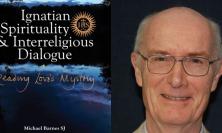On the forty-fifth anniversary of the promulgation of Nostra aetate, the Second Vatican Council’s decree on the Church and other faiths, Isabel Smyth SND examines the origins of the declaration, the enormous impact it had on inter-faith relations, and the questions it leaves us with today.
How the declaration came about
The 28th October will probably pass unnoticed by the majority of people and yet for the Catholic Church it is a significant date because, on 28th October 1965, Pope Paul VI promulgated the Declaration on the Relation of the Church to Non-Christian Religions, a document which was to transform the Church’s attitude towards other world religions and open it to inter-religious dialogue. It was one of the first documents to come to the floor of the Second Vatican Council but one of the last to be accepted because of the debate surrounding it.
When Pope John XXIII declared the Second Vatican Council and said that he wanted to open the windows of the Church so that the world could see in and the Church see out he did not have relations with other faiths in mind. But in 1960, John XXIII had a historic meeting with Rabbi Jules Isaac who presented the Pope with a book entitled ‘Contempt for the Jews’ which outlined the history of Christian anti-Semitism and appealed to him to remove anti-Jewish and anti-Semitic elements from Catholic liturgy.
As Cardinal Roncalli, the Pope had been Apostolic Delegate to Turkey and knew well the horrors of the Holocaust and how the history of anti-Jewish teaching and attitudes had provided the seedbed in which hatred of the Jews had grown. As a result of this meeting with Rabbi Jules Isaac, he asked Cardinal Bea to include the Church’s relations with the Jews in the Council’s agenda. Originally it was to be part of the document on Ecumenism but concern over its focus on Judaism, particularly from Bishops from Arab lands who thought it might have political implications, led to it being extended to cover Islam, Hinduism and Buddhism. It was eventually promulgated as a declaration in its own right and passed unanimously by the Council Fathers.
What the declaration said
The document is called, like all Church documents, by the first two words of the Latin title, Nostra aetate which means In Our Time and the first sentence reads, “In our time when day by day mankind is being drawn closer together and the ties between different people are becoming stronger the Church examines more closely her relations to non-Christian religions.” (NA 1) This was a historic moment, the first time that a Church Council had reflected on its relationship with other faiths in an official way.
At the heart of the document and the most developed part of the document is the section on Judaism. The Church’s history of relations with the Jews has been an unhappy one to say the least. Forced sermons, legal restrictions, forced expulsions, accusations of being God-killers had led to the Jewish community living in isolation and being subject to violence and abuse at the hands of Christians. The Jews were regarded as perfidious – God had rejected them because they had rejected the Messiah and the Church was now the new People of God, the true inheritors of the Covenant.
This traditional teaching was turned on its head as the Church acknowledged that Jews and Christians share a religious bond and spiritual legacy. The Church decried hatred, persecutions, displays of anti-semitism directed against Jews at any time and by anyone. Any sense of Jews being under a curse was rejected as was the accusation that they were responsible for the death of Jesus. There was no talk of the need to convert the Jews. Rather, the document said that ‘the church awaits that day, known to God alone on which all people will address the Lord in a single voice and “serve him shoulder to shoulder.”’ There was no sense that God had repudiated the covenant with the Jews. They are still His chosen people for “God does not repent of the gifts He makes or of the calls He issues” (NA 4)
These were strong statements in the light of history but some Jews were disappointed that there was no expression of sorrow or apology for past anti-Semitism. While some might have been disappointed, others realised its significance in overturning centuries of anti-Jewish attitudes.
Rabbi David Rosen, the American Jewish Committee’s head of Inter-religious Relations and Adviser to the Rabbinate of Israel, speaking recently in Scotland, said that he did not know of any other document or action that had so transformed human relations as Nostra aetate. For him Nostra aetate is a sign of hope that any relationship whether religious or political could be changed. This does not mean that all is plain sailing in the on-going relationship between the two communities. Plans to build a convent in Auschwitz, to beatify Pope Pius XII in spite of criticism over his silence about the Holocaust, to reinstate Bishop Williamson, a Holocaust-denier, to allow the use of the 1962 Roman Missal and translate the Good Friday prayer so that it speaks of the conversion of the Jews have put strains on the relationship.
In spite of this, relations and dialogue do continue and both Benedict XVI and John Paul II have visited the Rome Synagogue, Pope Benedict on more than one occasion. In his historic visit there Pope John Paul said, “The Jewish religion is not ‘extrinsic’ to us, but in a certain way is ‘intrinsic’ to our own religion. With Judaism therefore we have a relationship which we do not have with any other religion. You are our dearly beloved brothers and, in a certain way, it could be said that you are our elder brothers.” And on his most recent visit Pope Benedict recalled the words of Pope John Paul II: “Oh Lord, we are profoundly grieved for the behaviour of those who, throughout history, caused the suffering of the Jews, your children,” adding, “the Church has begged for forgiveness for anything it may have done to favour the evils of anti-Semitism and anti-Judaism. May these wounds be healed forever.”
Nostra aetate, however, is not just about the Jews. In Section Three, the document admits that the history between Christianity and Islam has also been characterised by “quarrels and hostilities” and calls on all to “forget the past and to work sincerely for mutual understanding and ……to promote together for the sake of all mankind social justice and moral welfare, as well as peace and freedom.” But it is in Section Two of the document that the Church makes what I think are three very important statements.
First of all the church clearly states that religious discrimination and harassment is wrong: “The Church reproves, as foreign to the mind of Christ, any discrimination against people or harassment of them because of their race, colour, condition of life or religion.”
Secondly she declares that there is truth and holiness in other religions: “The Catholic Church rejects nothing that is true and holy in these religions. She regards with sincere reverence those ways of conduct and of life, those precepts and teachings which, though differing in many aspects from the ones she holds and sets forth, nonetheless often reflect a ray of that Truth which enlightens all people.”
Thirdly the Church asks Catholics to “maintain good fellowship among the nations” and “through dialogue and collaboration with the followers of other religions, carried out with prudence and love and in witness to the Christian faith and life, to recognize, preserve and promote the good things, spiritual and moral, as well as the socio-cultural values” found in other religions.
These are amazing statements from a Church which had believed there was no salvation outside the Church. It is a far cry from a Church that in the 15th century had declared at the Council of Florence, “There is no doubt that not only all heathens but also all Jews and heretics and schismatics who die outside the Church will go into that everlasting fire prepared for the devil and his angels”. To recognise holiness and truth in other faiths gives them dignity, worth and respect. To recognize, preserve and promote the good things to be found in other faiths sets out an agenda for inter religious dialogue. Would the world not be a quite different place if instead of only defending their own positions, religions were seen to be witnessing to and promoting the good things to be found in others?
What happened next?
Nostra aetate did take seriously its duty to engage with others. Nostra aetate began a new era in Church relations with world faiths. On Pentecost Sunday 1964, before the document had even been promulgated, Pope Paul VI had instituted a special department of the Roman Curia for relations with people of other religions. Known at first as the Secretariat for Non-Christians, it was renamed in 1988 as the Pontifical Council for Interreligious Dialogue. Its responsibility was to promote mutual understanding, respect and collaboration between Catholics and the followers of others religious traditions, to encourage the study of religions and to promote the formation of persons dedicated to dialogue.
For the past forty years the Pontifical Council has being doing just that and more. Part its work is to send out annual letters of greetings to the major world faiths on their particular festivals. These letters are sent out through national Bishops’ Conferences and national Committees for Inter-Religious Dialogue and go to local communities and places of worship throughout the world. In Scotland these letters are accompanied by a letter from the Bishop President of the Committee for Inter-Religious Dialogue and always elicit a grateful response.
Nostra aetate laid a very firm foundation for the Church’s involvement in inter-religious dialogue. The example of Popes who have brought together religious leaders to pray for peace, as Pope John Paul did at Assisi, who have visited and prayed in Mosques and Synagogues, who have spoken of the importance of inter-religious dialogue and even asked forgiveness for the Church’s past attitudes, can leave no Catholic in any doubt about its importance in the life of faith.
The questions we are left with today
While there is no doubt that Nostra aetate was a landmark in the Church’s relations with other faiths, it does raise some theological questions, the implications of which have not yet been fully worked out. If truth and holiness are to be found in other faiths, where is the motivation for mission and evangelization? What does it mean to say that salvation is to be found in Jesus Christ if holiness and truth are to be found in others? The Vatican II documents do face these questions. In Nostra aetate the truth of others is a reflection of the “Truth that enlightens all people” and while recognizing the elements of truth and holiness in other religions, the Church does remind us that “she proclaims, and ever must proclaim Christ, ‘the way, the truth, and the life’ (John 14:6), in whom people may find the fullness of religious life, in whom God has reconciled all things to Himself.”
The Church is very clear that inter-religious dialogue does not do away with mission. The tension between the two was considered in two further Church documents: Dialogue and Mission, (1984) and Dialogue and Proclamation (1991) which said, “Just as interreligious dialogue is one element of in the mission of the church, the proclamation of God’s saving work in our Lord Jesus Christ is another ……..there can be no question of choosing one and ignoring or rejection the other” (DP 6).
Another Church document, this time a letter to the Bishops, written in the year 2000, entitled Dominus Iesus, said, “If it is true that the followers of other religions can receive divine grace, it is also certain that objectively speaking they are in a gravely deficient situation in comparison with those who, in the Church, have the fullness of the means of salvation.”(DI 22).
This statement which is trying to be true to the Church’s openness to others and to its own belief that it has the fullness of truth and salvation is a difficult one for anyone actually engaged in dialogue. A statement made within one’s own home sounds very different when made in the presence of others. For many faiths this statement sounded insulting and seemed to call into question the Church’s integrity in treating them as equal dialogue partners. Nor did it necessarily answer the questions that theologians had been wrestling with. For theologians engaged in inter-religious dialogue there are two basic questions: how do we understand Christianity in the light of other world faiths, and how do we understand other world faiths in the light of Christian teaching? How can we be true to our belief that God wills the salvation of all and yet limit the way to this through the Christian dispensation?
Theologians have answered these questions in different ways. Some of them like Jacques Dupuis and Peter Phan have come into conflict with Church authorities for taking a pluralistic approach which suggests that other faiths might too be part of God’s plan of salvation.
These questions will not go away. In fact they are likely to become more insistent as the Church continues to engage in dialogue with other faiths and to be part of theological discussion for many years to come. It will take many years to work out the implications of Nostra aetate. However, Nostra aetate did set the Church on a journey which, like all journeys, is an adventure into the unknown, and who knows where the Spirit might lead us in that journey? What we need is openness to that Spirit which blows where it wills and to allow ourselves to discover the riches and wisdom to be found in the traditions of others.
Sr Isabel Smyth SND is secretary to the Churches Agency for Inter Faith Relations in Scotland and Associate Secretary for Inter Faith Relations to the Scottish Catholic Bishops’ Conference. She was founding CEO of the Scottish Inter Faith Council and was awarded an OBE in 2006 for her services to inter-faith relations.






